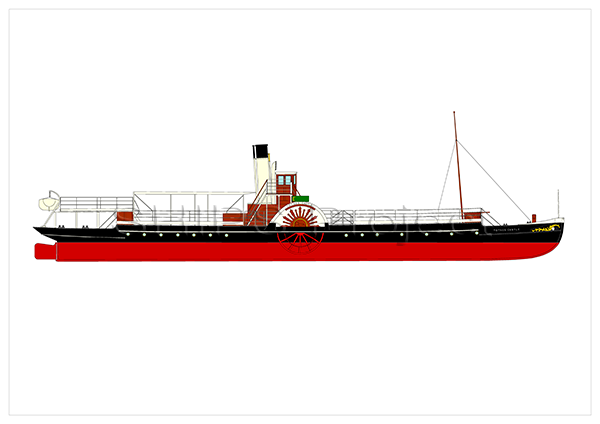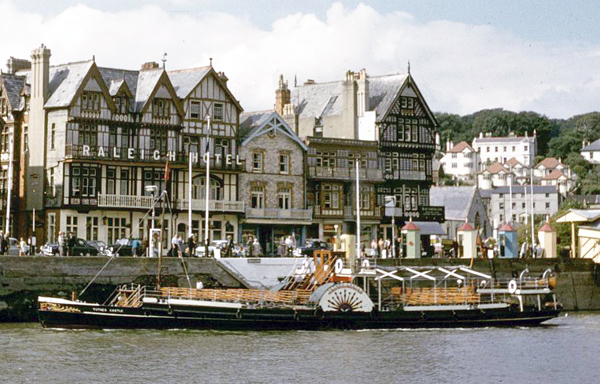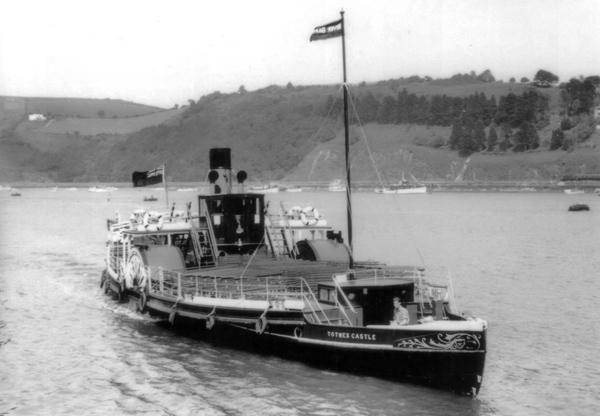Totnes Castle
The paddle steamer Totnes Castle was built in 1923 by the prolific shipbuilders Phillip & Son Ltd. of Dartmouth, she was the second vessel to bear the name with the previous ship launched in 1894 and scrapped in 1912. The 91 ton steel built steamer was powered by a two cylinder compound diagonal steam engine driving a centre mounted paddle wheel on each side of a long and narrow hull. The Totnes Castle was operated by the River Dart Steamboat Company running trips between Totnes and Dartmouth, she carried up to 400 passengers while drawing only 3ft of water so she was an ideal vessel for the shallow waters of the river Dart. In her heyday of the 1920s the cost of a trip was only 1s 9d for a single trip and motorcycles could be carried for 3 shillings as long as their fuel tanks were empty!
In 1939 all pleasure cruises on the river were suspended due to the declaration of war with Germany. In 1940 the Totnes Castle was requisitioned by the Admiralty and used as a liberty boat in Devonport Dockyard, but just one year later she was laid up. In 1941 the ship was again used to run pleasure cruises over the summer months but after the war the Totnes Castle resumed her trips up the Dart. By the 1960s the ship was nearly 40 years old and was in need of a major refit; it was estimated that the repairs would cost £6,000 so instead the River Dart Steamboat Company decided to replace her with a motor vessel. The company took advantage of a government loan scheme in order to build the new boat, the Cardiff Castle, and on delivery in July 1964 the wheelhouse and lifeboat from the Totnes Castle were transferred to the new ship and the ageing paddle steamer was laid up.
In the April of that year the Totnes Castle was converted to a 38 person accommodation vessel for a local sailing school, however this venture was unsuccessful and she was sold again the same year. She lay at her moorings on the Dart until 1967 when she was purchased by Ray Demelweek who then patched her up to be towed away to be scrapped. On the 9th November 1967 the Plymouth-based Reynolds tug Antony took up the tow to take her to Demelweek and Redding’s scrapyard at Marrowbone Slip in Sutton Harbour, Plymouth. Half way through the voyage they ran into heavy seas off Burgh Island, the tug accidentally pulled the low lying bow of the Totnes Castle into a heavy swell and she started to fill with water. The crew of the tug had just enough time to retrieve their towing hawser before the Totnes Castle sank in 40m depth in Bigbury Bay. The old paddle steamer was not worth a great deal and had been destined to be cut up so no attempt to salvage her was made.
Her sister ship Kingswear Castle was the last of a long line of paddle steamers to have been launched on the river Dart and has now been preserved as an exhibition vessel on the Thames. The bell of the Totnes Castle was removed when she was replaced and can now be seen in the Totnes Museum.
The wreck of the Totnes Castle lay undiscovered in Bigbury Bay until the Royal Navy hydrographic survey vessel HMS Gleaner relocated her in 1994. In June of that year the divers Dicky Dorrington, Mike Pellat, Richard Endicott and Steve Worth went to investigate the anomaly picked up by Gleaner’s survey and they found the paddle steamer lying upright on the seabed still with her portholes and other brass fixings intact.
Diving the Totnes Castle
The remains of the paddle steamer Totnes Castle lie upright in a shallow scour pit, at 44m, on a sand and gravel seabed with her bows to the south-east. The 30m long steel hull is buried up to her waterline but as a river boat with low freeboard the sides stand just a few metres high in places. Much of the ship had been removed before she left the Dart including the masts and wheelhouse and the remainder has collapsed over the years.
The single boiler is the most prominent feature of the wreck and the shot will normally lie just off this. Beginning the dive amidships you can see the skeletal remains of the starboard paddle wheel, however the port side one is completely gone. A section of hull beneath the forward passenger deck is still intact and it is possible to swim through a narrow opening towards the bow. The bow itself is largely collapsed save for the prow. The chain locker, replete with chain, can still be seen on the port side. Towards the stern the wreck is almost at seabed level with most of the structure collapsed. Several Conger Eels inhabit the wreck and Lobsters used to be seen on the site.
Due to the depth of the wreck it is recommended that only experienced divers attempt this dive. Air is can be used but Trimix, for those certified, is the gas of choice.
![]() If you have any more information about this ship then please contact us.
If you have any more information about this ship then please contact us.
Images
The Totnes Castle (SHIPS Project) |
The Totnes Castle at Dartmouth |
The Totnes Castle on the River Dart (SHIPS Project) |



